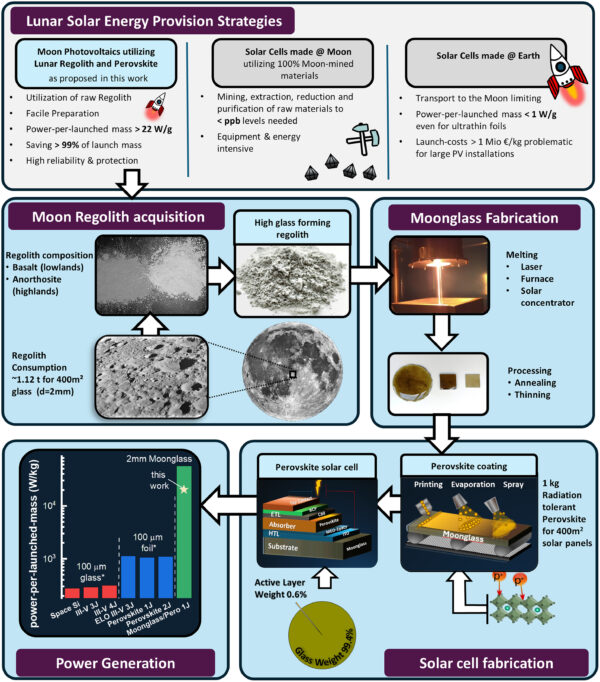German scientists have proposed power generation for future habitats on the moon could be achieved by manufacturing halide perovskite cells locally, using regolith-based moonglass.
A paper called Moon photovoltaics utilising lunar regolith and halide perovskites, which outlines the findings has been published in the scientific journal Device.
The University of Potsdam Institute of Physics and Astronomy scientists led by Julian Mauricio Cuervo-Ortiz say local production of perovskites on the moon would save 99% of material weight transport, enabling specific power ratios, over 22-50 W/g, a factor of 20-100 higher compared to traditional space solar solutions.
The scientists add this is achieved while not compromising radiation shielding, reliability, and mechanical stability as done until now.
“Using anorthosite high-glass-forming regolith simulant, we achieve transparent moonglasses that allow depositing high-quality perovskites,” the scientists say.
“We achieve performances on par with references, revealing the potential of perovskite-based Moon photovoltaics, and propose routes to achieve power conversion efficiencies of 23%.”
The research says the moonglass exhibits high tolerance to high-energetic proton irradiation, which, when combined with the radiation tolerance of perovskites, allows highly radiation-tolerant, reliable devices paving the way to future sustainable lunar-energy solutions.

Image: Cuervo-Ortiz, Julián Mauricio et al, University of Potsdam, Germany
This content is protected by copyright and may not be reused. If you want to cooperate with us and would like to reuse some of our content, please contact: editors@pv-magazine.com.









By submitting this form you agree to pv magazine using your data for the purposes of publishing your comment.
Your personal data will only be disclosed or otherwise transmitted to third parties for the purposes of spam filtering or if this is necessary for technical maintenance of the website. Any other transfer to third parties will not take place unless this is justified on the basis of applicable data protection regulations or if pv magazine is legally obliged to do so.
You may revoke this consent at any time with effect for the future, in which case your personal data will be deleted immediately. Otherwise, your data will be deleted if pv magazine has processed your request or the purpose of data storage is fulfilled.
Further information on data privacy can be found in our Data Protection Policy.